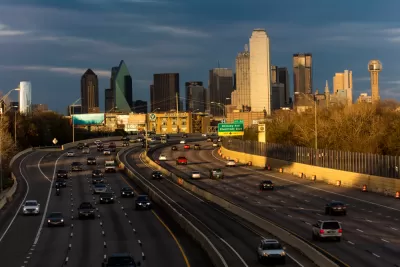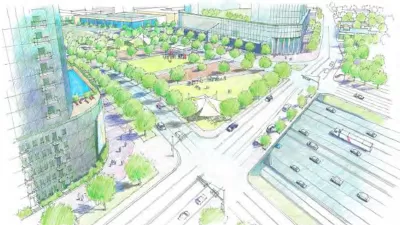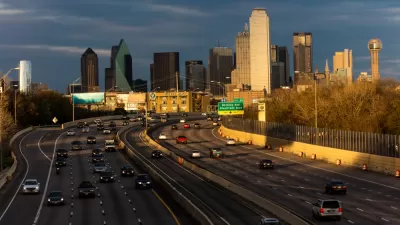A plan to widen the Interstate 30 in Dallas is pitting state transportation officials, with ostensible goals to serve regional transportation needs, against local officials, who are more concerned with "neighborhood-centric ideals."

Robert Wilonsky reports on the local resistance to a state plan to widen Interstate 30 in the heart of Dallas. The resistance is coming from City Hall.
"The Texas Department of Transportation last May sent Dallas City Hall a sneak peek at its plans to redo Interstate 30 East, from downtown past Fair Park to Haskell Avenue," writes Wilonsky, who goes on to describe the reaction of local officials.
Shocked because the state's transportation agency proposed to make the highway wider, with more lanes, exit ramps and frontage roads. Shocked because the design created more barriers between downtown and East Dallas, the Cedars, Fair Park and Deep Ellum, and gobbled up enormous swaths of real estate that could be used for development instead of more concrete. And shocked because TxDOT had proposed something that went against its very own CityMAP, the design document City Hall wholeheartedly embraced in the summer of 2016.
The Dallas Transportation Department has been working on a rebuttal, presenting the document [pdf] to the City Council's Mobility Solutions, Infrastructure, and Sustainability Committee this week. Local officials are hoping for the renovation of I-30 to reconnect South Dallas and Downtown while helping to revitalize Fair Park. The Dallas Transportation Department thus has proposed eight guiding principles it hopes the state will use to guide future refinements of the highway plan.
FULL STORY: Dallas City Hall beats back TxDOT's early plans for I-30's $1.3 billion makeover

Alabama: Trump Terminates Settlements for Black Communities Harmed By Raw Sewage
Trump deemed the landmark civil rights agreement “illegal DEI and environmental justice policy.”

Planetizen Federal Action Tracker
A weekly monitor of how Trump’s orders and actions are impacting planners and planning in America.

Why Should We Subsidize Public Transportation?
Many public transit agencies face financial stress due to rising costs, declining fare revenue, and declining subsidies. Transit advocates must provide a strong business case for increasing public transit funding.

Understanding Road Diets
An explainer from Momentum highlights the advantages of reducing vehicle lanes in favor of more bike, transit, and pedestrian infrastructure.

New California Law Regulates Warehouse Pollution
A new law tightens building and emissions regulations for large distribution warehouses to mitigate air pollution and traffic in surrounding communities.

Phoenix Announces Opening Date for Light Rail Extension
The South Central extension will connect South Phoenix to downtown and other major hubs starting on June 7.
Urban Design for Planners 1: Software Tools
This six-course series explores essential urban design concepts using open source software and equips planners with the tools they need to participate fully in the urban design process.
Planning for Universal Design
Learn the tools for implementing Universal Design in planning regulations.
Caltrans
Smith Gee Studio
Institute for Housing and Urban Development Studies (IHS)
City of Grandview
Harvard GSD Executive Education
Toledo-Lucas County Plan Commissions
Salt Lake City
NYU Wagner Graduate School of Public Service





























